Ses water analysis. Analysis of water from a well and a well: how and where to deliver water
When using well water, the key issue is its quality. After all, it may contain chemical elements and pathogens that can harm human health. To be sure of the safety of households is possible only after conducting research on its composition. How to properly analyze the water from the well and disinfect it after verification, we will consider in more detail.
Water quality analysis services are provided by both public and private organizations. Each federal district has accredited laboratories that have the authority to conduct such studies.
These include:
- sanitary epidemiological station;
- geological laboratories;
- laboratories in regional branches of Vodokanal;
- in organizations related to exploration;
- laboratories at research institutes;
- accredited laboratories of Rospotrebnadzor.
The price depends on the type of study. The analysis can be shortened, aimed at identifying a specific group of substances, or complex, including chemical and microbiological research.
In each of the listed institutions there are reagents and special equipment for testing water quality that are permitted by GOST requirements
Checking the biological group will cost about one and a half thousand rubles. A full assessment of the state will be released about three thousand. In private laboratories, the cost of the service can be more expensive.
When choosing a laboratory, you should be guided by two parameters, these are:
- Location and remoteness of the organization - because the key to the reliability of the results is the speed of delivery of the sample to the laboratory.
- Positive reputation - It is a guarantee of the quality of research. Copies of certificates and certificates can be requested from the manager of the selected organization.
Having decided on the choice of the laboratory, it remains only to coordinate with the employees the day of delivery of the sample so that the analysis is carried out as soon as possible.
Sampling for analysis
To take a sample from the source and determine the quality of the water, choose the off-season period. In the spring and autumn months, surface waters are most polluted. If they have the opportunity to penetrate into the mine, then they will certainly affect the composition.
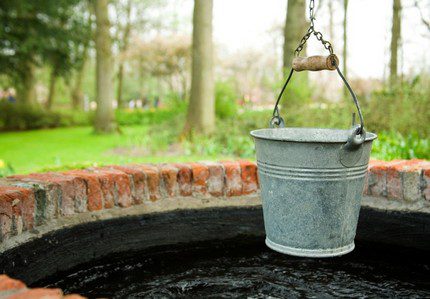
To check the quality of water from a newly constructed well, water for analysis should be taken no earlier than 3-4 weeks after putting it into operation
Water control is performed only after a 3-week period of operation of the hydraulic structure. During this period, the pollution of the mine that arose during construction works will settle down, and the water will partially clear.
To obtain reliable results from checking water from a well, it is important to properly sample. To do this, you must adhere to a number of simple rules:
- The liquid collection container must be made of clear, colorless glass or plastic. This can be a bottle of mineral or distilled water with a volume of 2 liters, or a glass two-liter bottle. It is unacceptable to use eggplants from under sweet and low alcohol drinks for these purposes if they have not been previously washed without the use of detergents.
- When taking water from a well with a bucket, try to empty it a little lower than usual. This decision is explained by the fact that closer to the surface the water may become stagnant, and include sludge impurities at the very bottom. Therefore, the "best middle ground" will be the best option.
- Before filling the dishes, they are rinsed with selected water. Well water is poured into the bottle in a thin stream so that it flows smoothly along the inner wall of the container. A pressureless flow will prevent the saturation of water with oxygen from the air, thereby preventing the occurrence of chemical processes.
- The bottle is filled with liquid at the very neck so that no air plug forms in the container. If using plastic bottle, before closing it tightly with a lid, squeeze the walls of the container slightly, squeezing out the air.
- Water taken from the well should be delivered to the laboratory within the next 2-3 hours. The faster the fluid enters the laboratory, the more reliable the results. If this is not possible, place the container on a shelf in the refrigerator - this will reduce the reaction rate.
The maximum shelf life of the sample is up to two days. During the storage period, temperature fluctuations should be avoided.
Image Gallery
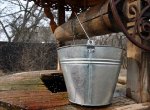

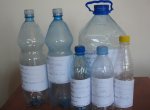

The biochemical processes taking place in the selected sample can affect the change in the composition of the liquid. To prevent this, the bottle with the selected liquid should be wrapped with a piece of dark cloth or polyethylene, which will not let in the sun.
An accompanying note should be attached to the well water bottle. In it indicate the place (address), type of source and the exact date of water withdrawal.

Under the influence of light rays in water, biochemical processes begin to occur, caused by the work of microorganisms living in it
Key performance indicators
To get a complete picture and determine how well water from a well is suitable for eating, you can perform a comprehensive analysis, which consists of two parts - a chemical and microbiological study.
General chemical analysis
Chemical analysis allows you to determine whether the water meets the current sanitary rules and norms (SanPiN 2.1.4.1074-01). Well water quality standards establish the maximum allowable amount of substances, as well as its sanitary and organoleptic characteristics.
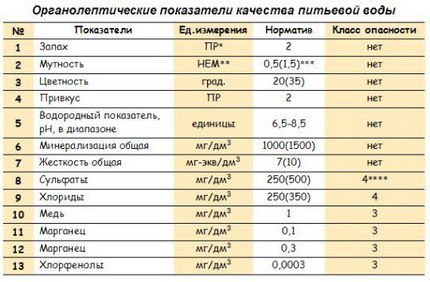
Chemical analysis helps determine the level of inorganic components that affect the quality of the investigated water environment
During the chemical analysis, the following indicators are determined:
- PH - hydrogen indicator. The development and vital activity of microorganisms depends on it, as well as the more aggressive effect of water on concrete and metals. Normally, the concentration of hydrogen should be 6-9 units.
- Turbidity - characteristic of relative transparency of water. It depends on the presence of mechanical impurities in the form of suspended particles of silt sediment, algae, clay and microorganisms.
- Color. The color of water is associated with its content of humic substances and iron compounds. The color intensity of the sample is determined based on the color scale. It can vary from several units to tens of thousands of degrees.
- Rigidity - the concentration of salt particles of magnesium and calcium in the liquid. An environment with increased stiffness provokes the formation of scale on heating appliances.
- Total mineralization. It indicates the total content of mineral substances found in the sample. Mineralization is characterized by an indicator such as solids.
- Permanganate Index - oxidizability of water. It is a measure of the pollution of the aquatic environment with organic and oxidizable inorganic substances.
The basic research methodology involves an assessment of 16 indicators, an extended one - includes more than 30.
One of the main indicators of water in the study of organoleptic qualities is its smell.
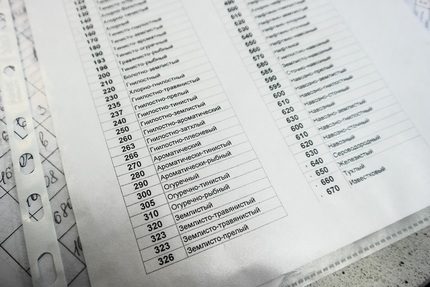
It is difficult to imagine, but laboratory specialists are able to distinguish over 50 shades of smell, having a natural and artificial origin.
The smell and taste of surface water directly depends on chemical composition impurities, as well as the concentration of rotting dissolved in water plant residues and dead microorganisms.
Microbiological components in the composition
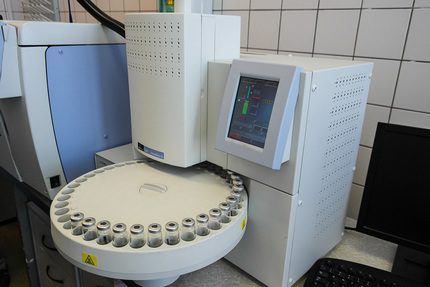
Microbiological analysis includes a wide range of studies aimed at identifying pathogens and viruses that can be harmful to human health.
The suitability of well water is determined by three main parameters:
- Total microbial number - per unit volume should be no more than 50.
- Thermo-tolerant coliform bacteria - reveals the content of microorganisms hazardous to health. The indicator must be zero.
- Common coliform bacteria - an indicator of fecal contamination. It must also be null.
Conducting microbiological research is especially important if the well has a depth of 10 meters. This is due to surface waters protozoa and various bacteria multiply much faster.
Besides well water should be checked for the concentration of fertilizers, surface detergent components and oil products. These substances often penetrate the mine during heavy rainfall.
Methods for purifying water from impurities
Having received the protocol on hand with the research parameters and indicating the maximum permissible values \u200b\u200bin accordance with SanPiN, they proceed to the choice of the method of how to properly disinfect the water in the well and clean it of impurities. The choice of method depends on the cause of contamination.
But in any case, before carrying out chemical treatment and installing filters, they perform mechanical cleaning of the well.
The method involves cleaning the bottom and walls of the well by scraping off accumulated layers with subsequent washing of the structure.
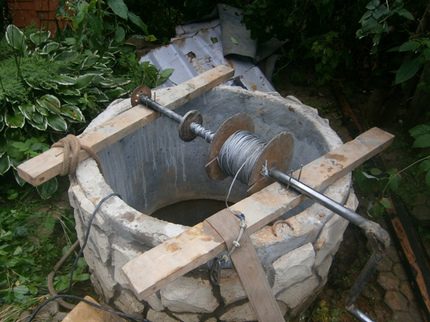
The cleaning procedure is best done in early spring until snowmelt or at the end of summer, when the lowest groundwater level is observed
Mechanical cleaning of a mine shaft includes a number of basic steps:
- Pump out water from the well. This can be done manually by scooping out with a bucket or using a drain pump. But it is worth considering that the mine cannot be completely emptied - there will always be a small layer of water at its bottom.
- They clean the walls of the structure. It is better to do the work together: the first worker, dressed in a protective suit, descends into the mine, and the second - insures it on the surface and accepts filled buckets. It is convenient to clean the walls of the well from mud or silt deposits with a wire brush or scraper.
- Replace the bottom filter. To do this, remove the layer-by-layer silt stones of the bottom filter layer by layer and remove them from the mine. Instead of the old bottom filter, a new layer of finely grained gravel is lined with neutral materials such as jadeite or river pebbles.
- Strengthen shaft rings and seal the seams. In the case of cracks, eliminate defects, covering them cement mortar. When displacement of the rings relative to each other is detected, the structure is strengthened by tightening the elements with metal brackets.
When replacing the bottom filter, natural sorbents can be used instead of regular crushed stone. Petrified oil or shungite has proven itself in water treatment systems.

Using shungite during the arrangement of the bottom filter, you will be able to solve two problems at once: filter the water by cleaning it from pesticides and oil products, and enrich it with useful minerals
Disinfection of walls of a hydraulic structure
After the completion of mechanical cleaning and elimination of leaks, the structure is disinfected. It is performed by applying a disinfectant solution to the inner walls of the mine with subsequent treatment of well water.
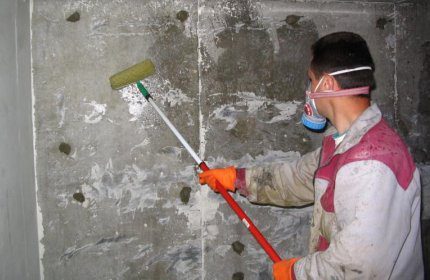
The walls of the mine are treated with a solution of bleach obtained by diluting 20 grams of powder in a liter of cold water
The solution is prepared in a glass or enameled container and insist it under a tightly closed lid for 1-2 hours. For disinfection use only a layer of the mixture that has emerged closer to the surface. In the case of using pure chlorine to obtain a 2% solution, the powder is diluted at the rate of 3-5 grams per 1 liter of liquid.
For applying the solution it is convenient to use a wide brush and a fur roller. It should cover the entire surface evenly. The remainder of the solution is treated with a bottom filter.
Well water disinfection
If the liquid analysis showed infection with bacteria, after mechanical cleaning and disinfection of the walls of the hydraulic structure, water must also be disinfected. The easiest way is to disinfect bleach.
For this, the treated shaft is again filled with water. Then a more concentrated solution obtained by diluting 200 grams of powder per liter of water is poured into it. To disinfect water, one cubic meter of liquid on average takes 500 ml of solution.
Chlorine-treated water cannot be consumed. Before putting the mine into operation, it will have to be emptied again and filled from scratch.
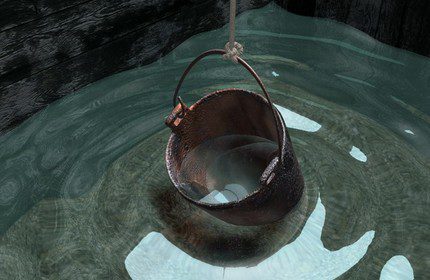
Mixing the chlorine solution with water in the mine is performed by scooping a bucket and pouring the contents back into the well
The mouth of the well with the solution introduced into the water is covered with a lid wrapped in plastic wrap, and leave for a day. Such measures will help keep the mine cool, preventing the escape of chlorine.
If, after filling the well, the smell of chlorine is still present in the water, it is better to re-pump the liquid and wait until the structure is filled with a new portion of groundwater.
Disinfection of the building can also be carried out using special preparations such as Ecobriz-Oxy or Aquatabs.
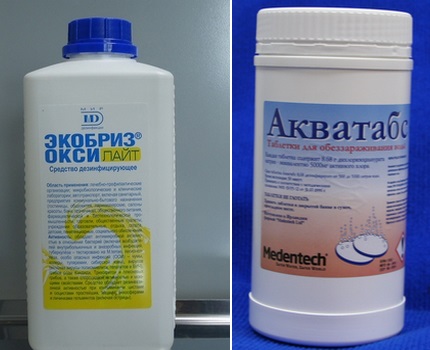
Concentrated preparations for obtaining disinfectant solutions are simply diluted with water and used according to the same technology as in the treatment with bleach. In the first 5-7 days after disinfection, it is advisable to boil well water before eating it.
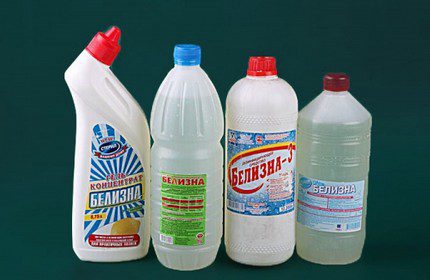
If you get special means there is no way, use the usual "White" - a bleaching agent based on the same chlorine
To get a solution of the required dosage, half a bottle of "White" is bred in a ten-liter bucket with cold water. The volume of solution required to process the contents of the entire mine is determined at the rate of 1 liter of fluid obtained per 1 ring of the well.
The resulting solution in quality and effectiveness will not be inferior to its more expensive counterparts.
Iron reduction
There are many ways to defer water. But all of them are based on the acceleration of oxidative processes, aimed at ensuring that iron goes into a trivalent state. In this form, iron-containing products precipitate in solid particles, which can only be filtered.
The easiest way to iron removal is the use of potent oxidizing agents. They destroy iron compounds, translating them into a trivalent state. Most often, chlorine is used as an oxidizing reagent. A toxic reagent can destroy not only iron compounds, but also divalent manganese, hydrogen sulfide, as well as many other substances of organic origin.
For deferrization, special filters are used, the inner walls of which are coated with a layer of oxidizing agent. In contact with the surface, iron enters into a reaction, as a result of which it becomes a precipitate and is easily cleaned with filter material.
Successfully solving the problem helps the installation of reverse osmosis.

A reverse osmosis system equipped with a semi-permeable membrane or filters is able to purify water from iron in high concentrations without the use of chemical oxidizing agents
The aeration method has proven itself well. It is carried out by introducing air into the water using a compressor that creates differences atmospheric pressure. For this, water in the well is sprayed with special installations through gushing or showering.
Removal of hydrogen sulfide from a liquid
Hydrogen sulfide is a waste product of anaerobic bacteria. Sulfur bacteria live at the bottom of the well, where oxygen does not enter.
Experts offer two ways to solve the problem:
- Physical - assumes the saturation of the liquid with air. Forced aeration helps to destroy the sulfur bacteria and additionally saturate the water with oxygen, making it more healthy. To implement this method will have to purchase expensive equipment.
- Chemical - involves the use of disinfectants and oxidizing agents: sodium hydrochloride, hydrogen peroxide or ozone. It provides the most complete degassing. Under the influence of oxidizing agents, hydrogen sulfide compounds pass into less active forms.
Cleaned fluid chemically, should be further filtered through activated carbon. For water purification use as carbon filtersequipped with activated carbon, and filters with granular filler.
Water treatment with a solution of potassium permanganate helps to fix the problem. The potassium permanganate powder is first diluted in a three-liter jar to obtain a concentrated solution of a saturated violet color, and then poured into a well. Subsequently, to prevent the formation of colonies of bacteria producing hydrogen sulfide, it is recommended to periodically perform a “purge” with compressed air.
Video reviews of methods for disinfection of well water
Equipment for the control of harmful impurities:
Reagentless water purification method:
Which filter to choose for cleaning dirty water:
In the future, in order to maintain proper water quality in the well, an analysis of its aquatic environment should be carried out annually. This will make it possible to control the quality of the water used, and in case of deterioration, take timely measures to improve the situation.
In its significance to humans, water is second only to air. We drink this liquid daily, because without it our body cannot exist.
If the water contains impurities harmful to health, then it turns from life-giving moisture into a slowly acting poison. For this reason, analysis of water from a well is of paramount importance for residents of cottage villages and cottages.
The one who believes that this procedure is enough to be carried out once after a well is dug in a section or a well is drilled is mistaken. The chemical and bacteriological composition of groundwater is constantly changing.
Therefore, one should not relax for a long time, having received positive results of the analysis. Negligent neighbors who dug a cesspool near your site and heavy rains washing away fertilizers from the fields can drastically degrade quality drinking water in your well.
How to make water analysis from a well or a well promptly and efficiently, how samples are taken, and which contaminants pose the greatest danger, we will consider in our article.
To drink or not to drink - is that the question?
This Hamletian dilemma also holds true for the water we draw from the well.
The first and simplest step in the analysis of the quality of drinking water is known to all. In scientific terms, it is called organoleptic research. Each owner of the estate can conduct it.
To do this, just pour water into a clean glass jar and look through it at sunlight. If the liquid is transparent, does not have floating particles, an extraneous color cast, and bad smellThey boil it and look at the surface. A thin colored film on it indicates the presence of petroleum products in the underground aquifer. This phenomenon is not uncommon for estates located near busy motorways or tank farms.
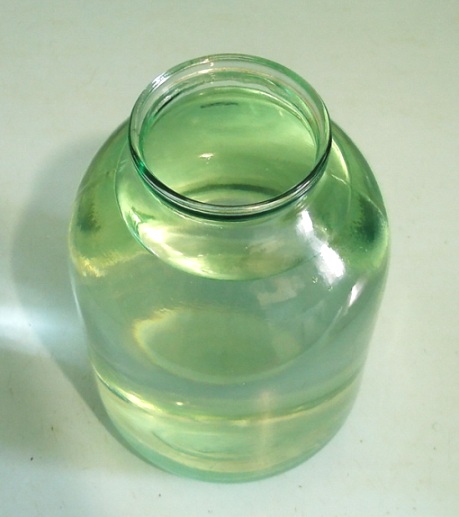
After a visual assessment, the water is tasted. If she does not have an unpleasant aftertaste, then the first stage of the analysis can be considered completed.
Laboratory methods for the analysis of drinking water can reveal what our eyes cannot and feel the taste buds. This is the presence of harmful viruses, bacteria and germs in the drinking fluid. Visually and to taste, the water can be completely normal, but it does not comply with sanitary standards.
We also have to upset the owners of artesian wells. The technogenic load on the soil today is such that even at a depth of several tens of meters dangerous biological and chemical pollution. Permanent companions of artesian wells - iron and manganese require the use of neutralizing agents. Their quantity can be established only after an accurate chemical analysis. Therefore, you should not rely only on the depth of your well. It is better to spend reasonable money on complex research.
The answer to the question of where to take water for analysis is very simple. The verdict on complete bacteriological safety can only be given by the SES (Sanitary and Epidemiological Service). It is in this organization that all owners of home wells and artesian wells should contact.
In addition to the microbiological, several other important types of research are practiced here:
- General analyzes evaluate in detail the organoleptics of water (hardness, lack of oil products, concentration of iron, nitrates, manganese, calcium, silicon, magnesium, sulfides and pH).
- Chemical can accurately determine the amount of chloroform, free chlorine, silver and other elements.
- Radiological investigations are aimed at detecting elevated concentrations of radionuclides, primarily natural radon gas.
- Toxicology determines the absence or presence of lead, phenols, pesticides and aluminum in water.
An analysis of the quality of drinking water can be done using one of the listed categories of pollution, or you can order a comprehensive study that will provide an exhaustive answer to all questions.
Sanitation specialists can go home, or at your request can give sterile containers for self-sampling. In the second case, the total cost of services will be lower.
What you need to know for self-sampling of water?
Observing a few simple rules, you will be able to correctly select a test sample of water for research in the laboratory:
- The optimal capacity of glass or plastic containers for complex analysis is 1.5 - 2 liters;
- The container must be thoroughly rinsed with water, from which the sample will be taken without using cleaning and detergents;
- To exclude stagnant water from entering the tank, it is necessary to pump out water from the source within 10-15 minutes;
- Water is poured into the container in a thin stream along the wall in order to avoid its saturation with atmospheric oxygen;
- The liquid should fill the container under the cover so that there is no air in it that distorts the test results.
- The most accurate result can be obtained provided that the time interval between sampling and its examination is minimal (no more than 2-3 hours). If you do not fit within this period, then the sample should be placed in the refrigerator. In this case, its shelf life does not exceed 12 hours.
The sampling procedure for microbiological analysis is more complex. To carry it out, you need to take a sterile container in the laboratory.
The water collection process consists of the following operations:
- wash hands with soap;
- without touching the neck of the bottle with your hands, remove the cotton-gauze plug from it;
- the bottle is filled with water to the "shoulders", closed with a rubber stopper (comes complete with a paper cap);
- the cap is fixed with an elastic band on the neck;
- the bottle is labeled indicating the place, time and date of selection;
- the sample must be brought to the laboratory within 2 hours from the time of filling (in the morning). If prompt delivery is not possible, the shelf life in the refrigerator is a maximum of 6 hours.
A complete picture, as we have already said, can be provided only by a comprehensive analysis of water, carried out by the SES or in any laboratory accredited for such studies.
At home, this work can also be done, but for a limited number of indicators. To do this, you need to buy a special kit for express analysis of water. It consists of special reagents and test colorimetric rulers. The research procedure takes no more than 10 minutes and is available even to an untrained person.

The test kit can determine the following parameters of water from a well or a well:
- rigidity;
- color
- manganese;
- ammonium;
- total iron;
- fluorides;
- nitrates.
There are a number of portable photometer devices designed to assess water quality. Unfortunately, they are quite expensive (from 60,000 to 200,000 rubles), which is why they are used by laboratories for conducting analyzes in the field.
Estimated cost of analyzes
The definition of water quality should be approached differentially. If you are worried about its bacterial composition (proximity to cesspools, toilets, agricultural enterprises), then you can order an analysis only by microbiological parameters. Its average price is from 1800 to 2,000 rubles.
Minimum chemical analysis for 9 indicators (turbidity, odor, oxidizability, color, hardness, pH level, manganese, iron +2, iron +3) will cost you in the amount of 1,000 rubles. The average cost of an extended study of chemical composition (according to 18 indicators) ranges from 2,500 to 3,000 rubles.
The laboratories carry out a comprehensive analysis of the quality of drinking liquid for 5,000 - 7,000 rubles.


